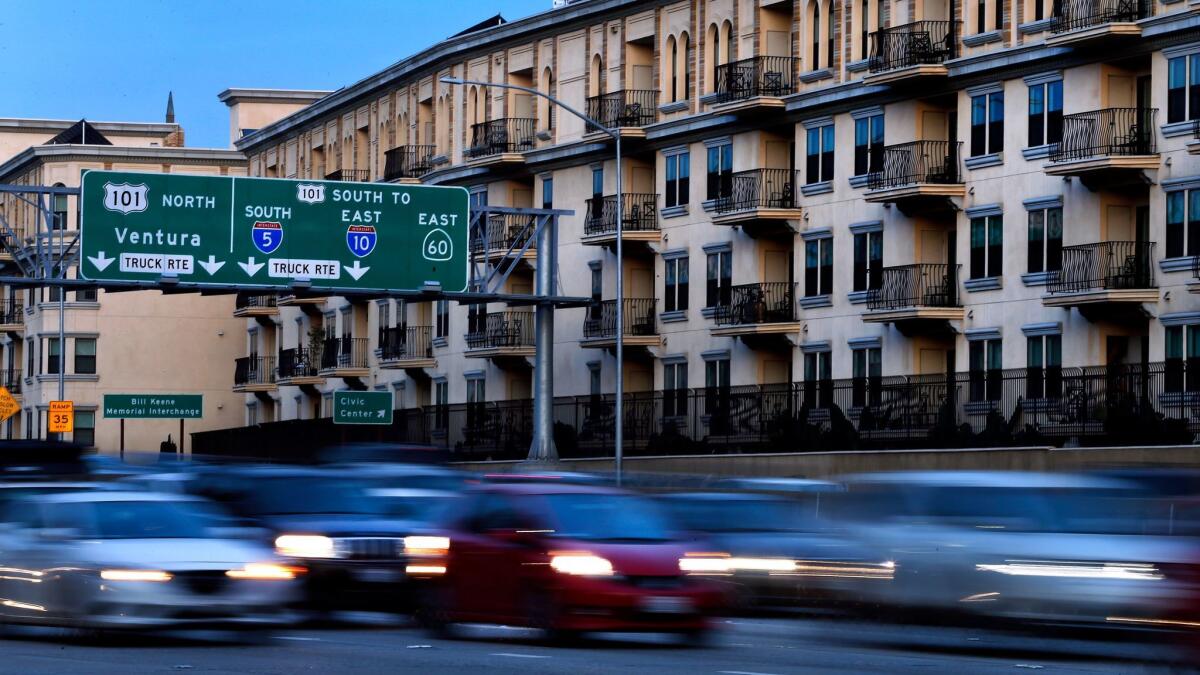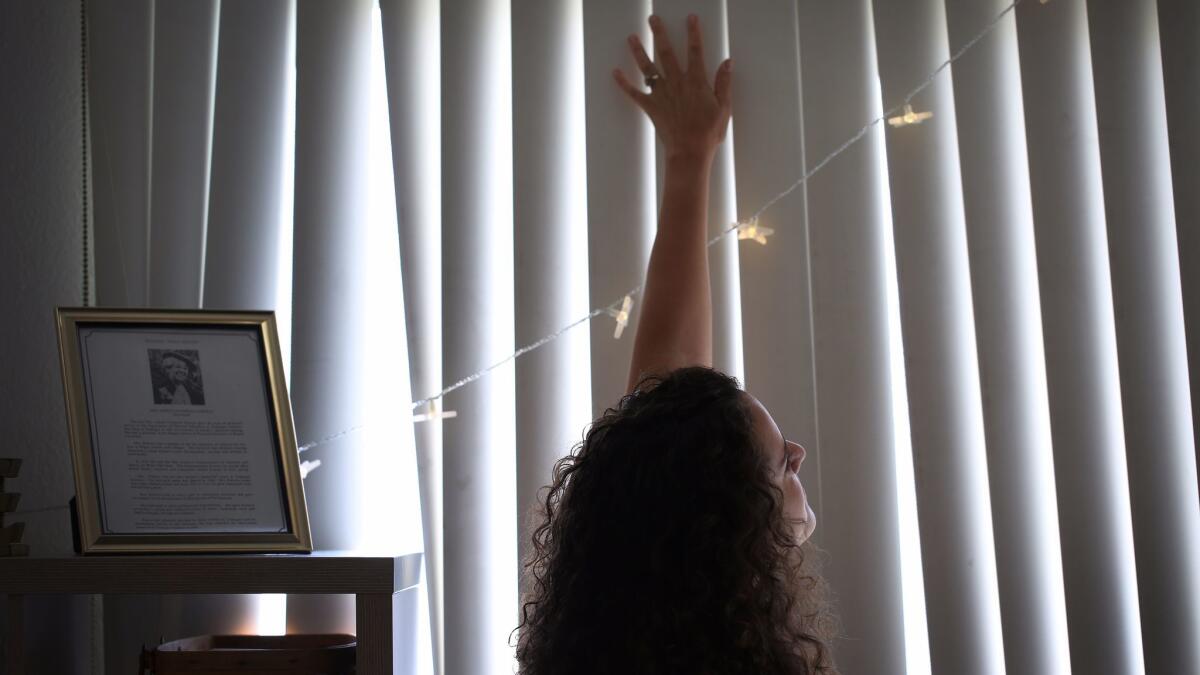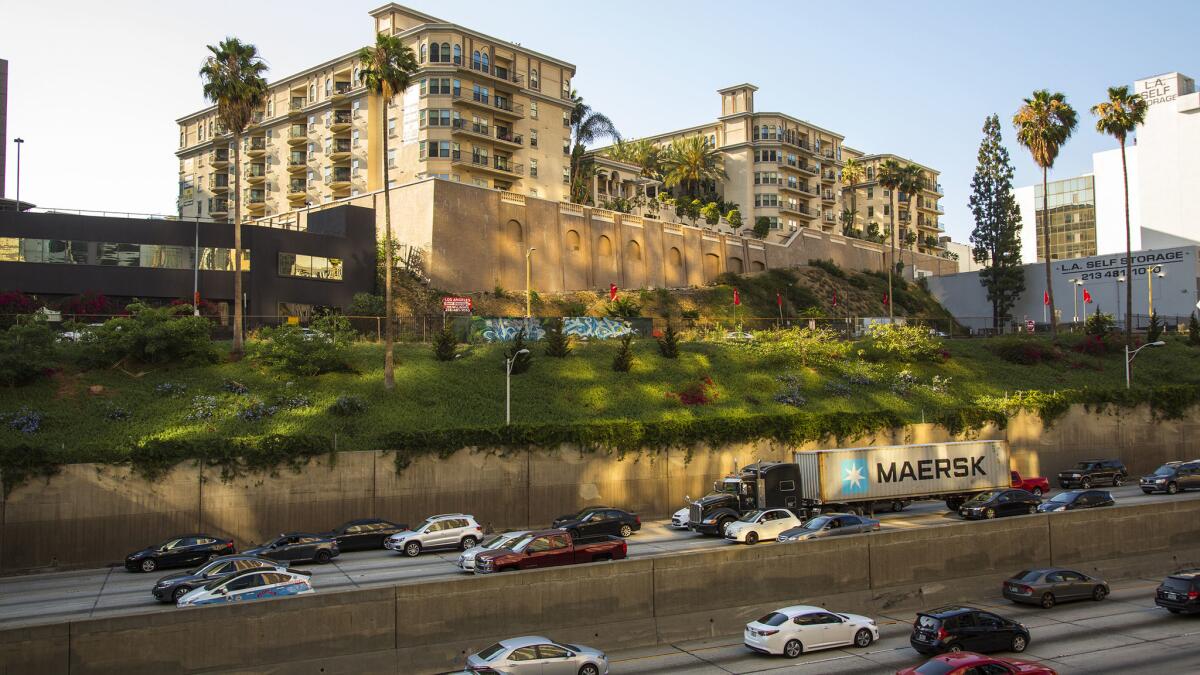L.A. requires air filters to protect residents near freeways. Are they doing the job?

Despite growing warnings about the health problems tied to traffic pollution, Los Angeles officials continue to approve a surge in residential development along freeways. And the crux of their effort to protect peopleâs lungs is a requirement that developers install air filters.
But even the highest-quality filters capture only some of the dangerous ingredients of car and truck exhaust, and to be effective, experts say, they must be frequently replaced and the buildingâs ventilation system must run virtually full time with all doors and windows closed.
The city inspects new projectsâ air-filtration systems, but the head of the Department of Building and Safety concedes that his office has no procedures for documenting whether the proper filters were installed and does not conduct follow-up inspections to ensure that theyâre being maintained and replaced.
Air-quality regulators and health experts warn that relying on air filtration and other mitigation measures will not solve the health threat to residents moving into new homes along freeways â Southern Californiaâs biggest conduits of pollution.
They have for over a decade urged cities to stop permitting new housing within 500 feet of heavy traffic to protect residents from asthma, cancer, heart attacks, preterm births and an array of other health problems studies have associated with living close to major roadways.
Yet, Los Angeles in 2015 issued building permits for 4,300 homes close enough to freeways to threaten occupantsâ health â more than in any year over the last decade. Since then the city has permitted more than 3,000 additional units within the 1,000-foot distance where the city advises developers that residents are at risk from air pollution, with at least one just 60 feet from freeway traffic.
Health vs. housing
Mayor Eric Garcetti and other local politicians have opposed limits on how many homes can be built near freeways on the grounds that it would hamper efforts to ease Los Angelesâ severe housing shortage.
Builders agree, noting that additional restrictions on new construction will increase the cost of housing. âAnd we have a very, very high need for housing,â said Tim Piasky, who heads the Building Industry Assn. Los Angeles/Ventura Chapter.
Environmental advocates and neighborhood groups, meanwhile, call for stricter development standards and freeway buffer zones to protect residentsâ health.
Doug Haines of the East Hollywood Neighborhood Council told city council members at a recent hearing that fine particulates will damage the lungs of children in hundreds of new housing units proposed along the 101 Freeway.
âIt passes through door jambs and window frames. There is no realistic way to filter it,â Haines said. âThe only way to stop this is to limit all construction next to freeways.â
Researchers have for years studied how to protect the health of people living near traffic pollution.
In a report released in April, the California Air Resources Board reviewed more than a decade of scientific studies and highlighted what it said are âpromising strategiesâ to help decrease pollution exposure for residents close to freeways when cities do not heed its warning against building homes within 500 feet.
Among the solutions endorsed by the agency are sound walls, vegetation barriers and âbuildings with varying shapes and heightsâ to help disperse traffic pollutants.
âItâs basically giving people a second set of solutions to the problem,â said Bart Croes, research division chief at the Air Resources Board.
High-efficiency air filters are among the most effective tools, but neither the Air Resources Board nor most air-quality experts consider them an adequate fix.

What filters can miss
âFiltering the air for particles is better than nothing,â said Scott Fruin, a professor of preventive medicine at USCâs Keck School of Medicine. But heâs skeptical of cities that believe filters are an adequate solution. Studies show, for example, that high-quality air filters can capture some of the harmful particles in traffic emissions, but do not keep out toxic exhaust gases.
âThe carbon monoxide, the volatile organics, benzene or 1,3-Butadiene, theyâre going to be too high and the filtration wonât take care of that,â Fruin said.
Air-quality officials have also advised cities that the benefits of filters are significantly undermined if the buildingâs heating, ventilation and air conditioning system isnât running at all times with all doors and windows closed.
UCLA doctoral student Amelia Mueller-Williams said that even though she tries to keep the windows of her student housing apartment near the 405 closed, she still finds black dust in tissues when she blows her nose.
âOur home is polluted in every sense of the word,â she said.
And such housing keeps getting approved.
In 2013, over the air districtâs objections, the Los Angeles City Council unanimously approved developer M. David Paulâs 325-unit Il Villaggio Toscano project in Sherman Oaks right next to the 405-101 interchange. The city required only that the apartments have high-efficiency air filters and that certain windows facing the freeway canât be opened.
Attorney Robert P. Silverstein, who sued the city, challenging its approval of the project on behalf of a neighborhood group, called such restrictions âa joke.â
âThereâs a reason they call these kinds of apartments âblack lung lofts,â â said Silverstein. âSome of these units are mere feet away from the busiest freeway intersection in the country.â
Rick Coca, a spokesman for Councilman JosĂŠ Huizar, who chairs the cityâs Planning and Land Use Management committee, said Huizar voted for the Il Villaggio Toscano development because it had the support of the local council member at the time, Tom LaBonge.
Former Councilman LaBonge said he voted for the project because it had the support of the planning pepartment, was located on an empty parcel next to the Sherman Oaks Galleria mall and would help satisfy âthe need for housing.â
Live near the freeway? Tell us your story Âť

Not all filters are alike
In April 2016 Los Angeles changed its building code to require high-efficiency air filtration in new homes within 1,000 feet of a freeway.
Filters are rated on a 16-point industry scale â the Minimum Efficiency Reporting Value, or MERV â that measures how effectively they block tiny pollution particles.
Studies of Southern California classrooms conducted by South Coast Air Quality Management District and UC Riverside scientists between 2008 and 2010 found that high-performance panel filters with MERV ratings of 13 to 16 removed between 70% and 90% of particle pollution. More common MERV 7 filters removed about 50%, the researchers found.
The stateâs current filtration standard for new homes is MERV 6.
Under the ordinance Los Angeles adopted, filters must meet a performance rating of 13. The standards are similar to those in San Francisco, which since 2008 has required that level of air filtration in new housing near high-traffic roadways.
Los Angeles officials said they chose to require MERV 13 filtration in part because it was the most realistic option.
Shana Bonstin, a principal planner at the city planning department, said officials were concerned that if they set a more stringent standard âwe could be setting ourselves up for a situation where the filters donât get replaced or maintained: If we placed too burdensome of a requirement, would the trade-offs be too great?
âWe wanted to find that perfect balance,â she continued, âwhere residents are provided the most protection and realistically the buildings were going to continue to maintain them.â
To work properly, all filters must be replaced between two and four times a year. And higher-rated filters are more expensive. A level 13-to-16 filter costs between $20 and $90, compared with $6 for a common MERV 8 filter, according to a December 2016 planning department report.
The city has in a few isolated cases required developers to install filters even stronger than those now required. Back in 2006, planning officials required developer G.H. Palmer to install level-16 filters at the Piero apartments near the 110 Freeway in Westlake to offer greater health protections to occupants, âremoving 99.97% of all airborne contaminants at 0.3 microns,â according to a list of requirements imposed by the city as a condition of approval.
The city required similar MERV 16 filtration for the 335-unit Clarendon Apartments approved this year for construction on land abutting the 101 Freeway in Woodland Hills.
Jennifer Gordon, a spokeswoman for developer AMCAL Multi-Housing, Inc., said apartment units would be situated âa minimum of 60 feet from U.S. 101â and that the âcommunity is purposely designedâ to face away from the freeway, with a parking structure, a row of trees and a 60-foot residential building insulating areas of the development from traffic.
The City Council unanimously approved the project in March. Mayor Garcettiâs office signed off on it. Demolition has begun and the developer expects to finish construction by summer 2019.
Asked why he continues to approve such projects, Garcetti said: âThings have gone through because theyâve been in the pipeline and city council has approved those.â Stopping them, he said, would raise huge legal questions and be a financial burden for investors.
Garcetti said he has directed city staff to look at how the cityâs zoning can be changed to protect public health.
Earlier this year council members and the mayor backed a new study of development restrictions, design standards and other steps the city could take. In a written statement, Garcettiâs spokesman said âno one should ever have to choose between affordable housing and breathing clean, healthy airâ and cited a city sustainability plan that sets goals for reducing emissions, electrifying vehicles and increasing public transportation and transit-oriented development.
Past problems
Neighborhood activists have long complained that the city has ignored or failed to enforce promises extracted from developers as conditions of approving their projects, including enhanced air filtration requirements for homes near freeways.
âThereâs no filter police,â said Silverstein, the attorney who has challenged Los Angelesâ approval of residential projects. âThe developers can say, OK, weâre going to do this. But itâs meaningless because the city is never going to go back and check.â
After inquiries from The Times, the Department of Building and Safety in 2014 found that two apartment complexes developed by Geoffrey H. Palmer â the 526-unit Da Vinci apartments and the 913-unit Lorenzo, both along the 110 freeway in L.A. â had failed to install the proper-strength filters or the equipment necessary to accommodate them.
At the cityâs request, the developer of the Da Vinci later installed more powerful fan motors in the ventilation system to support thicker filters, said Jeff Napier, a spokesman for the cityâs Department of Building and Safety.
At the Lorenzo, where lower-strength filters were already in place, the developer installed new ones âwith larger surface area to accommodate the existing equipment,â Napier said.
Napier said he was not aware of any other projects where the Department of Building and Safety had stepped in.
Councilman Huizar said he hoped the cityâs latest filtration rules would improve things âby making this a uniform baseline regulation instead of a case-by-case condition.â He has asked city staff for data on how the air filtration standards are going and said âwe all want assurances that the program is being implemented.â
Have the right filters been installed?
The Los Angeles Department of Building and Safety inspectors review building plans and verify air-filtration standards âthroughout the project, up to and including the final inspection,â Napier said. But the city doesnât keep records documenting whether high-grade air filters were installed as they do other health and safety features, such as smoke detectors.
âThereâs no set form that checks a box that absolutely the filters were installed,â Napier said. âWe have a construction boom going on right now. It would be counterproductive to document every little thing that we approve.â
Unless it receives a complaint, the city does not conduct follow-up inspections to see if air filters are being maintained and replaced because there is no requirement in the building code, said Frank Bush, the building and safety departmentâs general manager.
âThatâs on the building owner,â Bush said âIf we got a complaint we would take action, but nothing proactive.â
Mayor Garcetti said he supports a mandatory âcheck boxâ to track whether the promised air filters are being installed.
âThat would be an easy thing to fix if theyâre not,â Garcetti said. âThis is not a sink finish, this a health issue and so it should have the highest priority.â
The new filter standards will not help the 600,000 people who, a Times analysis of 2010 U.S. census data indicates, were then living within 1,000 feet of Los Angeles freeways.
One of them is Victor Johnson, 61, who has three air-filtration machines running in his one-bedroom apartment about 300 feet from the 101 Freeway in Studio City. He said he hasnât seen much improvement in his air quality.
He blames his ongoing health problems, which include chronic headaches, colds, inflammation and high blood pressure, on the pollution, which leaves a layer of fine black dust on his shelves and counters.
âThree filters and still this ultra-fine dust thatâs a fine, fine black powder,â Johnson said. âIâm concerned about my lungs. I can deal with the embarrassment of my furniture being dusty. But I donât want the same issues as a coal miner.â
Times staff writers Chris Keller, Jon Schleuss and David Zahniser contributed to this report.
ALSO
Explosion, major fire rocks DWP power station; large swath of Valley without power
Political Road Map: Hereâs how aging baby boomers will change the impact of Prop. 13
Oxnard residents are fighting slag heaps, power plants and oil fields that mar the townâs beaches
More to Read
Sign up for Essential California
The most important California stories and recommendations in your inbox every morning.
You may occasionally receive promotional content from the Los Angeles Times.











